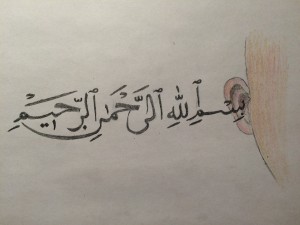Mar
21
Week 2: Sacred Sound
March 21, 2016 | Comments Off on Week 2: Sacred Sound

This week, we discussed the role that sound plays in Muslim worship. Sound and aural elements are at the very roots of Islam, beginning with the initial spread of Muhammad’s revelations. In “Reading the Qur’an”, Ziauddin Sardar writes, “Sound plays a very important part in the structure of the Qur’an. Before it was a written text, the Qur’an existed as sound; this is why it is often compared to an epic poem” (14). Muhammad began to spread God’s word orally, by speaking to other people, who then spoke the same things to others, and so on. The Qur’an was only written down and integrated into a single material book later on; before that, it existed in people’s memories.
Although this is no longer the case today, sound continues to play a major role in Islam. I chose to make this drawing as a representation of the act of listening, and as a statement of the importance of sound in the religion. The Imam’s call to prayer is an integral part of the daily soundscape in many modern Muslim cities. Additionally, Qur’an recitations are popular, both in their role as a form of worship and as a sort of art or entertainment form. Sardar writes, “Even to this day, millions of Muslims continue to commit the entire Qur’an to memory. Listening to Qur’an recitation is a popular art form, one in which the entire audience would be aware of any mistake that disturbed the sound structure as much as it would the meaning of what is being recited” (15).
To represent the importance of sound within Muslim culture and worship, I used colored pencils to draw a visual representation of the act of hearing the basmalah, the invocation of God that is recited before almost every sura, or chapter, of the Qur’an. Translated, it means, “In the name of God, the Merciful, the Compassionate.” The basmalah is an essential component of Muslim worship, and one that is heard and spoken aloud often. The picture shows an ear, separate from distinctive features of any individual human being, representing the universality of the experience. The way in which the basmalah leads directly into the ear and is connected to it represents the view that the Muslim listener is one with God and with the word of the Qur’an. I depicted the act of listening as a whole, holy, and self-contained experience.